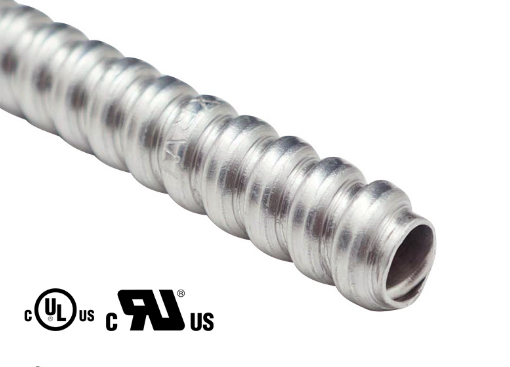Providing an inherent mechanical barrier for cabling, flexible conduit offers more than just protection for cables and installations. It allows users and specifiers to do things differently, challenging traditional installation practices and offers unrivalled product performance.
Benefits of Using Flexible Conduit
1. Simplicity and Versatility:
The utilization of flexible conduits eliminates the necessity for specialized cables, allowing for the grouping and safeguarding of standard and single-core cables within a single system. This simplicity streamlines the process, accommodating various types of cables without the need for specialized components.
2. Efficiency in Installation:
Combining cables within flexible conduits significantly reduces the number of cable entry points and terminations. Installation becomes swift and hassle-free with an array of securing options that don’t require specialized tools. This expedites the fixing process, contributing to faster project completion.
3. Long-Term Adaptability:
A standout benefit lies in its adaptability throughout the lifespan of the installation. The ease of adding circuits as needed and accommodating alterations in the installation's requirements makes it a cost-effective and future-proof solution.
4. Enhanced System Integrity:
Flexible conduits can be tailored to match the specific hazards of an installation. They offer a reliable solution for safeguarding critical cabling, ensuring system integrity even in challenging environments.
Comparing the advantages of flexible conduit to rigid conduit:
- Elimination of Additional Accessories: Flexible metal conduits negate the need for bending or corner accessories, simplifying the installation process. Moreover, there’s no requirement for cutting threads, making the entire process more straightforward.
- Adaptability for Various Applications: These conduits are suitable for both static and dynamic applications, offering adaptability across diverse installation needs.
- Strength and Maneuverability: Their superior strength-to-weight ratio makes them a preferred choice. Furthermore, the coiled nature of the products, as opposed to straight lengths, makes them easier to handle and maneuver during installation.
- Tool-Free Installation: Their installation doesn’t demand specialized tools, adding to the ease and efficiency of the process. This contributes to a more cost-effective installation overall.
Comparing flexible conduit fittings to cable glands:
- Streamlined Cable Management: Flexible conduit fittings enable the grouping of multiple cables within a single system, reducing the number of terminations required.
- Space Efficiency: These fittings require reduced physical glanding space for cable terminations, optimizing space usage within the installation.
- Reliability and Maintenance: With fewer points of entry, the risk of system failure diminishes. Faulty cables can be replaced without necessitating an entire system overhaul, making maintenance more convenient and cost-effective.
- Upgrade Flexibility: The ability to upgrade and add circuits with ease further cements the advantages of flexible conduit fittings, offering scalability and adaptability as per evolving needs.
- Sealing without Compression: Unlike traditional cable glands, these fittings don’t compress the cable to ensure sealing, preserving the integrity of the cables being protected.
- Ease of Retrofitting: Flexible conduit fittings can be retrofitted effortlessly, adding to their appeal for various applications.
- Compatibility and Swifter Installation: Their compatibility with multiple cable types makes them a versatile choice. Additionally, their quicker installation process contributes to overall time savings during projects.
In conclusion, the employment of flexible conduit and its associated fittings presents a multitude of advantages in terms of simplicity, adaptability, efficiency, and reliability in safeguarding cables across various applications and installations.

评论
发表评论